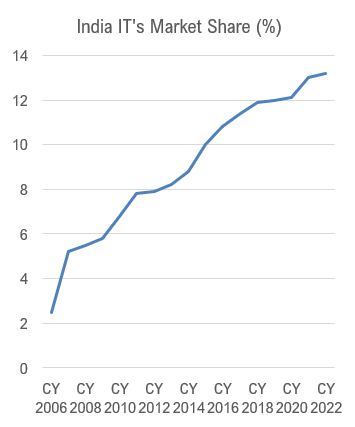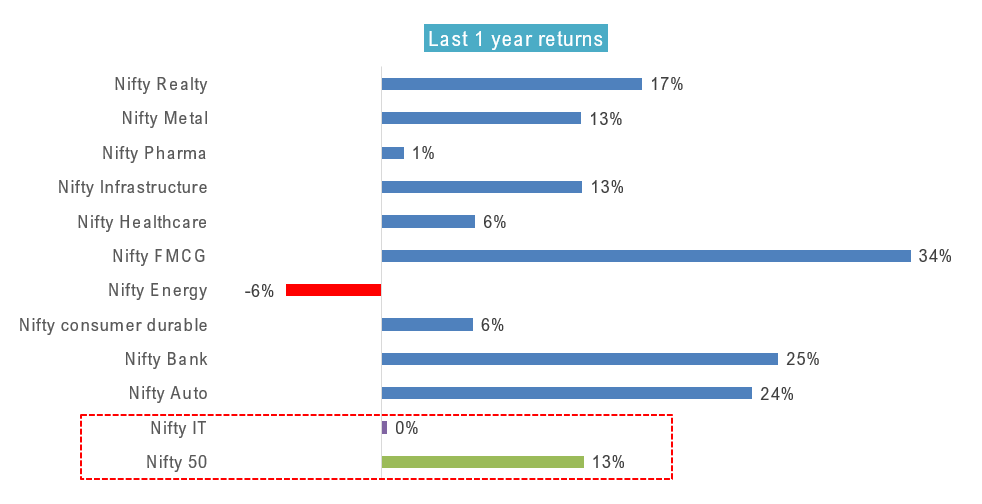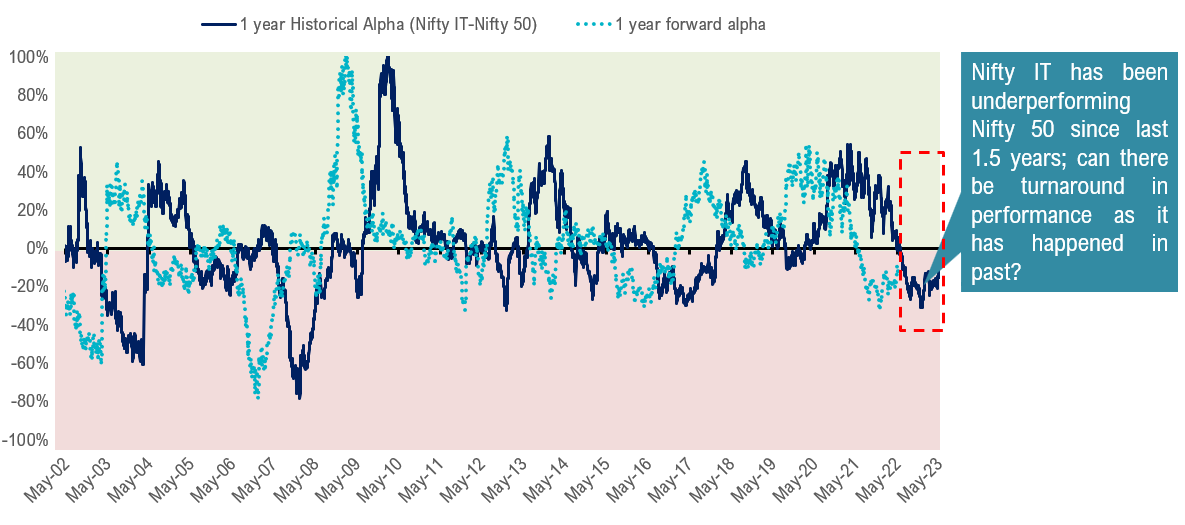Summary
The Indian Information Technology (IT) sector showcases robust growth driven by skilled workforce, competitive costs, and supportive government policies. Indian IT firms have gained global prominence with superior financial metrics and attractive valuations compared to global peers. Despite recent underperformance, historical trends indicate potential for future growth, buoyed by sector dynamics and cyclical patterns. Retail investors can access this opportunity through direct stock investments, albeit requiring diligent research. Alternatively, IT-focused mutual funds and Exchange Traded Funds (ETFs) offer diversified exposure and professional management, catering to both long-term investors and those seeking trading flexibility in the sector.
In the ever-evolving landscape of investment opportunities, one sector stands out as a beacon of potential and prosperity - Information Technology (IT) in India. As the industry witnesses a surge in technological advancements and innovation, the Indian IT market offers a fertile ground for investors seeking attractive avenues. The stability of earnings and consistent growth of IT companies further enhance its allure. Investors can tap into the abundant opportunities presented by this sector and unlock a realm of limitless potential.
Unprecedented growth and economic contribution

Over the past three decades, the IT sector in India has experienced remarkable growth, transitioning from humble beginnings in 1992 to a significant contributor to the economy. This transformation reflects the rapid development and capability of the Indian IT industry.
One of the key drivers behind this growth was India's focus on becoming a global outsourcing hub for IT services. The availability of a skilled English-speaking workforce, competitive labour costs, and improvements in telecommunication infrastructure played a vital role in attracting multinational companies to establish their operations in India. This led to the rapid expansion of IT-enabled services, including software development, Business Process Outsourcing (BPO), and Knowledge Process Outsourcing (KPOs).
Additionally, the Indian government implemented policies to support the IT sector's growth, The government is further aiming for technology and digital economy to make 20% of India’s GDP by 2025-26.<a href="https://economictimes.indiatimes.com/tech/technology/targeting-technology-be-20-25-of-indian-gdp-by-2025-26-mos-it-rajeev-chandrasekhar/articleshow/101103058.cms?from=mdr">Mr Rajeev Chandrasekhar,</a>````MoS ITeconomictimes.indiatimes.com/tech/technology/targeting-technology-be-20-25-of-indian-gdp-by-2025-26-mos-it-rajeev-chandrasekhar/articleshow/101103058.cmsrecently remarked that the Indian innovation economy has grown from the 4-5% in 2014 to 10% today and they aim to take it higher.
This progress was facilitated by initiatives such as offering tax incentives, simplifying regulations, and establishing Special Economic Zones dedicated to IT and IT-enabled services. These measures created a conducive environment for domestic and international IT companies by fostering innovation, job creation, and foreign direct investment (FDI) inflows.
The rise of Indian IT companies in the global market

The opening up of the IT sector in India hoisted the industry into the big league. As seen from the chart above, the market share of Indian IT companies in the global arena has witnessed substantial growth, increasing from a little over 2% in 2006 to over 13% in 2022. This growth showcases the expanding influence and competitiveness of Indian IT companies in the global market. They have been successful in capturing a significant portion of the global IT services market by offering cost-effective services, leveraging a skilled workforce, developing domain expertise, focusing on innovation, adopting a global delivery model, and forming collaborative partnerships.

As seen from the chart above, Indian IT export growth is higher than World IT spending growth over past 2 decades. This also points towards the growing dominance of Indian IT companies in World IT spending.
Indian IT sector outperforms global IT with financial strength and attractive valuations

A comparison of the fundamental metrics of evaluation of the Indian IT sector with the global IT industry highlights the Indian IT sector's advantage for growth and investment opportunities. The NIFTY IT index, representing Indian IT companies, demonstrates higher Return on Equity (ROE%) and Return on Assets (ROA%) compared to the NASDAQ 100 index that represents IT companies in the US.
As seen from the chart above, the NIFTY IT index shows an ROE% of 25.4% versus 19.2% for the NASDAQ 100, indicating better returns for investors. Additionally, the NIFTY IT index achieves an ROA% of 16.2% surpassing the 7.7% of the NASDAQ 100, demonstrating higher profitability from their asset utilization by Indian IT companies.
Regarding valuations, the NIFTY IT index presents more attractive indicators compared to the NASDAQ 100. The NIFTY IT index boasts a lower price-to-earnings (P/E) ratio of 25.2 vs P/E ratio of 31.4 by NASDAQ 100, suggesting that Indian IT companies are relatively cheaper in relation NASDAQ 100. Furthermore, the NIFTY IT index exhibits a lower price-to-book (P/B) ratio of 6.4 v/s P/E ratio of 7.1 of NASDAQ 100, indicating that Indian IT companies are valued more reasonably based on their book value compared to NASDAQ 100.
These financial indicators and valuations demonstrate the Indian IT sector's superior financial strength and investment potential compared to the global IT industry. With higher profitability, better asset utilization, and more favorable valuations, the Indian IT sector presents a compelling proposition for investors seeking investment opportunities in the technology sector.
Recent underperformance of the IT sector

The graphs above show that the sector is below its peak valuation levels from the past, while the following infographic indicates lower recent performance as compared to the other sectors in the last 1 year.

But is the recent underperformance Bad News?

Historical data shows that underperformance is followed by overperformance, a trend observed across various industries and financial markets.
So, the IT sector may be poised for growth with the factors contributing to this growth including market dynamics, investor sentiment, adjustments and restructuring within underperforming sectors, and the cyclical nature of markets and the economy. It may just be the right time for investors to place their bets on the Indian IT industry.
How can you capture the potential of the Indian IT sector?
Below are some ways in which a retail investor can take part in the opportunities presented by the IT sector:
Investing in direct stocks: Carefully analyze and assess IT company stocks, peers, industry trends, and the market. Purchase stocks of selected IT companies to directly benefit from their success. However, this approach comes with high risks as returns are tied to specific companies and it’s difficult to identify the good ones. Thorough research and analysis are essential to identify strong companies with growth potential. You must also monitor and rebalance the portfolio as needed. All in all- a tough ask for a regular investor.
IT-focused Mutual Funds: Investing in IT-focused mutual funds ensures a broader exposure to multiple IT companies within a single product. This reduces the concentration risk associated with investing in individual stocks. There is also the advantage of a professional fund manager who navigates the choppy waters on your behalf.
Exchange Traded Funds: ETFs are types of mutual funds that provide the best of both worlds - direct stocks as well as mutual funds. ETFs are designed to mirror and track the performance of specific indices or the sector. Think of this option as the ability to directly purchase ‘a unit of the Indian IT index’. They offer diversification like mutual funds, as they hold a basket of securities, but they can be bought and sold throughout the trading day at market prices, like direct stocks. This flexibility allows investors (as well as those who might want to trade) to additionally gain from (almost) constant liquidity of the product

Industry insights you wouldn't want to miss out on.
Disclaimer
All content on this blog is the intellectual property of DSPAMC. The user of this site may download materials, data etc. displayed on the site for non-commercial or personal use only. Usage of or reference to the content of this page requires proper credit and citation, including linking back to the original post. Unauthorized copying or reproducing content without attribution may result in legal action. The user undertakes to comply and be bound by all applicable laws and statutory requirements in India.
*In this material DSP Asset Managers Pvt. Ltd. (the AMC) has used information that is publicly available, including information developed in-house. Information gathered and used in this material is believed to be from reliable sources. The AMC however does not warrant the accuracy, reasonableness and / or completeness of any information. The above data/ statistics are given only for illustration purpose. The recipient(s) before acting on any information herein should make his/ their own investigation and seek appropriate professional advice. This is a generic update; it shall not constitute any offer to sell or solicitation of an offer to buy units of any of the Schemes of the DSP Mutual Fund. The data/ statistics are given to explain general market trends in the securities market and should not be construed as any research report/ recommendation. We have included statements/ opinions/ recommendations in this document which contain words or phrases such as “will”, “expect”, “should”, “believe” and similar expressions or variations of such expressions that are “forward looking statements”. Actual results may differ materially from those suggested by the forward looking statements due to risks or uncertainties associated with our expectations with respect to, but not limited to, exposure to market risks, general economic and political conditions in India and other countries globally, which have an impact on our services and/ or investments, the monetary and interest policies of India, inflation, deflation, unanticipated turbulence in interest rates, foreign exchange rates, equity prices or other rates or prices etc.
- Mutual Fund investments are subject to market risks, read all scheme related documents carefully.**
 Account Statement
Account Statement  Capital Gain Statement
Capital Gain Statement  Key Information Memorandum
Key Information Memorandum  PAN Updation
PAN Updation  Register / Modify KYC Online
Register / Modify KYC Online  Nominee Registration
Nominee Registration  Email / Phone Updation
Email / Phone Updation  OTM / eNACH Registration
OTM / eNACH Registration  Guidelines for Incapacitated Investors
Guidelines for Incapacitated Investors  FAQs
FAQs Reach us
Reach us















Comments
Total 2
P n v r saibaba
23-09-2024
ETF can only be sold via market trading You should also make available to sell the units like units in any fund
Vaidhy L
23-09-2024
Excellent article, very informative and easy to understand with eye catching visuals. I like the indepth analysis and insights shared by DSP analysts. Keep up then good work. It would also be helpful to mention the related schemes launched by DSP and also launch more new schemes (not restricted to IT sector only).
Write a comment